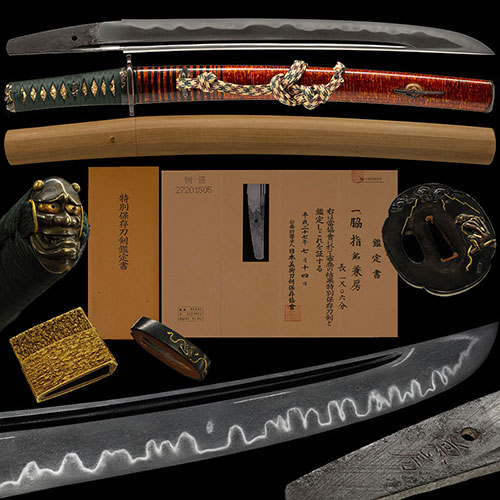
兼房 寸延短刀Kanefusa Sunnobi Tanto
No.897387寸延短刀 兼房 平造寸延短刀 時代白檀塗鞘名作拵付 兼房乱典型優品 一尺六分Sunnobi Tanto Kanefusa Hiradukuri Sunnobi Tanto With Jidai Byakudan(Sandalwood) Nurisaya Meisaku Koshirae, Typical Kanefusa-Midare A masterpiece 32.2cm
ご成約Sold
- 銘表Mei-Omote
- 兼房兼房 Kanefusa
- 登録証Registration
- 東京都 Tokyo 平成26年9月20日 9/20/26(Heisei)
- 時代Period
- 室町後期Late Muromachi period
- 法量Size
-
刃長 32.2cm 反り 0.2cm
元幅 0.0cm 先幅 0.0cm 元重 0.55cm 鎬厚 0.00cm 先重 0.00cm 鋒長 0.0cm 茎長 10.2cm 重量 202gHachou 32.2cm Sori 0.2cm
Moto-Haba 0.0cm Saki-Haba 0.0cm Moto-Kasane 0.55cm Shinogi-Thikess 0.00cm Saki-Kasane 0.00cm Kissaki-Chou 0.0cm Nakago-Chou 10.2cm Weight 202g - 国Country
- 美濃Mino
- 姿Shape
- 鎬造、庵棟、身幅広く、僅かに反りつく。Shinogidukuri, Iorimune, Wide Mihaba, Slightly Sori-tsuku.
- 鍛Kitae
- 板目肌に、杢目・流れ肌交じり、地沸微塵に付く。Itamehada, Mokume, Mixed Nagarehada, Jinie entered finely.
- 刃文Hamon
- 焼き幅大きな互の目に、丁子刃交じり、飛び焼き掛り、足よく入り、小沸つく。Gunome with a large grill width, Mixed Choujiba, Tobiyaki-kakari, There are many Ashi, Small-Nie-tsuku
- 帽子Boushi
- 乱れ込んで先掃きかけて尖りごころに返る。Midarekonde-Sakihakikakete Togarigokoroni-Kaeru
- 茎Nakago
- 生ぶ、先栗尻、鑢目檜垣、目釘孔一。Ubu, Sakikurijiri, YasurimeHigaki, Mekugiana is one(1)
- ハバキHabaki
- 金着二重。Double layered gold
- 拵Sword mounitings
- 白檀塗腰笛巻塗鞘拵 (江戸時代)
法量
長さ50.2cm 反り1.3cm
説明
鐔 赤銅磨地雷神図高彫金色絵。 縁頭 赤銅石目地般若図金色絵。 目貫 赤銅おかめひょっとこ図。 小柄 赤銅磨地稲荷図。 飾金具 赤銅素銅地柿図金色絵。
付帯する拵は、白檀塗の鞘に、般若の縁頭、雷神図の鐔、仲秋の月図鐺、桔梗図鐺、鞘の飾り金具には柿の実が付く。割れや目立つ傷も一切ない名品である。Byakudan(Sandalwood)-Nuri Koshifuemaki Nurisaya Koshirae (Edo period)
Length:50.2cm
Sori:1.3cm
Tsuba:Syakudou Migakiji Raijinzu Takabori Kiniroe
Fuchigashira: Syakudou Ishimeji Hannyazu Kiniroe
Menuki:Syakudou Okame Hyottokozu
Koduka: Syakudou Migakiji Inarizu
Kazarikanagu: Syakudou Suakaji Kakizu Kiniroe
The accompanying Koshirae are Saya painted with Byakudan (sandalwood), Fuchigashira depicting Hannya, Tsuba depicting the Raijin(God of thunder), Kojiri depicting the Chu-syu-notukizu(Mid-autumn moon), Kojiri depicting Kikyozu(bellflowers), and the Kazarikanagu of the Saya has a Kakinomi(Persimmon fruit )attached. It is a masterpiece with no cracks or noticeable scratches. - 説明Drscription
- 兼房は、関善定派の刀工で、古くは室町前期永享頃の清左衛門兼房に始まり、関鍛冶の頭領である惣領職を代々務めた。兼房乱れを創始した大永頃の兼房、後に氏房と改名する永禄頃の兼房が有名である。永禄の兼房は、天分三年生まれ、名を河村京三郎といい、後に清左衛門と改め、弘治二年兄より善定家総領職を譲られる。永禄十三年氏房と改め左衛門尉に任じ、若狭守に転じている。この刀は、銘より永禄の兼房と思われ、互の目に、丁子刃交じり、典型的な兼房乱れの優品である。Kanefusa is a swordsmith of the Seki Zensei school, which began with Seizaemon Kanefusa around Eikyo in the early Muromachi period, and has served as the head of the Seki blacksmiths for generations.Kanefusa around the Taiei era, who founded Kanefusa Midare, and Kanefusa around the Eiroku era, who later changed his name to Ujifusa, are famous.Kanefusa of Eiroku was born in the third year of Tenbun, his name was Kyozaburo Kawamura, later changed to Seizaemon, and in the second year of Koji he was given the position of head of the Zensada family by his older brother. In the 13th year of Eiroku, he changed his name to Ujifusa, was appointed Saemonnojo, and became Wakasa no kami.
This sword is believed to be Kanefusa of Eiroku from Mei(inscription), Gunome, Mixed Choujiba, and is an excellent piece with a typical Kanefusa-Midare.



